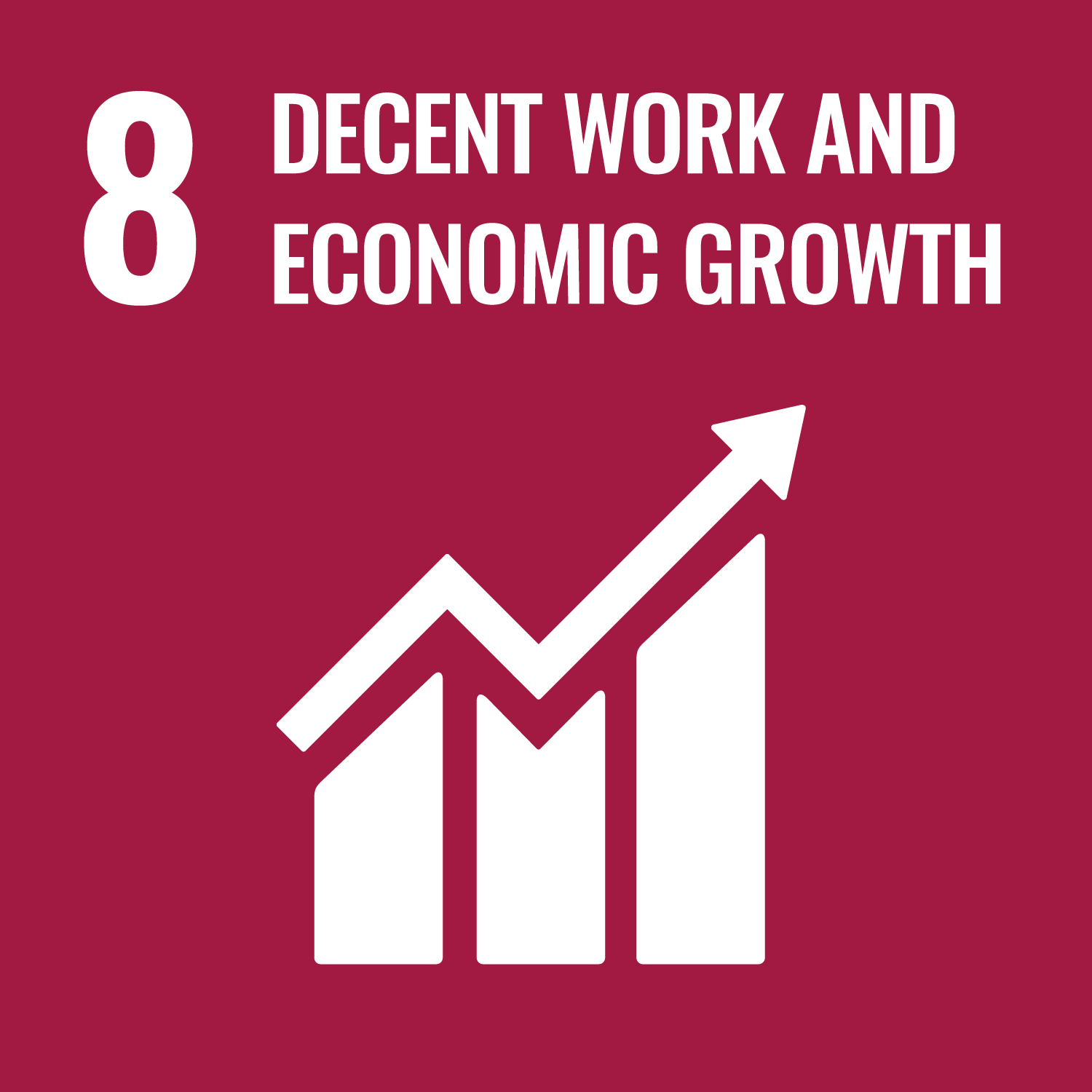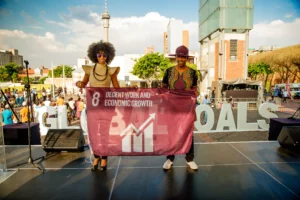Generally speaking, our data show that at this pace, we won’t achieve decent work for all by 2030. Progress in labour markets around the world has been too slow and uneven to ensure a sustainable future with decent work opportunities for everyone.
But it’s not all gloomy: we have made great progress in many areas! We just need a reminder to pick up the pace and expand our efforts to more areas.
The ILO's role in SDG monitoring
In 2015, all United Nations Member States adopted the 2030 Agenda for Sustainable Development, which introduced the 17 Sustainable Development Goals (SDGs) to be achieved by 2030 to ensure peace and prosperity for people and the planet. In order to monitor progress towards achieving these 17 goals, the SDG Global Indicator Framework was created, made up of 232 different indicators covering all areas of development.
The ILO has a longstanding history (over 100 years!) dealing with issues pertaining to the world of work and promoting decent work for all. That is why it was chosen as the custodian agency for 14 indicators related to the labour market in the SDG Global Indicator Framework. This means that every year (since the adoption of the SDGs), the ILO Department of Statistics is responsible for submitting data on all these indicators for the Global SDG Indicators Database as well as methodological information and a brief analysis of what the data show.
Below is a summary of what we have submitted this year.
Goal 1 - End poverty in all its forms everywhere
The share of the world’s workers who live in poverty has continuously and dramatically declined since the beginning of the century: the global working poverty rate fell from 26% in 2000 to 7% in 2019.
What is more, the gender gap in working poverty has almost been bridged, with a difference of less than a percentage point between the female and the male global working poverty rates in 2019.
However, the situation is less encouraging for young workers, who have a much higher likelihood of living in poverty than adult workers. In 2019, 13% of the world’s young workers lived in poverty, compared to 6% of the world’s adult workers.
Goal 5 - Achieve gender equality and empower all women and girls
In 2019, 28% of managerial positions in the world were occupied by women, while women represented 39% of the world’s workers and half of the world’s working-age population.
This suggests that women face additional barriers to access employment, and once in employment, to access decision-making positions in management.
The increase in the female share in management since 2000 (when it stood at 25%) is far too modest to be encouraging.
Also, strong regional disparities exist in women’s access to management. Whereas in some regions more than a third of managerial positions were held by women in 2019 (41% in Eastern Europe and South-Eastern Asia and the Pacific, 40% in Northern America, and 39% in Latin America and the Caribbean), women accounted for only 8% of managers in Northern Africa.
Committed efforts are needed to ensure women’s full and effective participation and equal opportunities for leadership around the globe.
Goal 8 - Promote sustained, inclusive and sustainable economic growth, full and productive employment and decent work for all
Labour productivity growth
The average output produced per worker in the world has continuously increased since the beginning of the century, with its growth interrupted only (and briefly) during the global economic downturn of 2009.
The levels of labour productivity growth vary across regions: while in the past few years, labour productivity has declined in Latin America and the Caribbean, it has risen everywhere else and especially fast in Asia.
Informality
Taking into account all those working in informal sector enterprises or activities as well as all those holding informal jobs in the formal sector, 61% of the world’s workers were in informal employment in 2016. Informality is especially far-reaching in agriculture: 94% of the world’s agricultural workers held informal jobs or jobs in the informal sector in 2016.
Informality in agriculture clearly affects women more, with the agricultural informality rate being higher for women in all regions with data.
Earnings
Equal treatment in employment is part and parcel of decent work, but unfortunately, we are far from achieving it.
Equal treatment in employment is also part and parcel of decent work. The median gender pay gap in countries with recent and comparable data (based on hourly earnings) is close to 12%, meaning that in half of all countries with data, women’s hourly earnings are on average 12% lower than men’s hourly earnings. However, this gender pay gap is a raw calculation based on average hourly earnings, thus not controlling for characteristics such as the sector, the occupation, the educational level or the work experience. In fact, a global study done by the ILO found a factor-weighted gender pay gap of 19% (Global Wage Report 2018).
Data on average hourly earnings can also cast light on other types of income inequality, such as the differences in pay from one occupation to another. In fact, in 87% of countries with data, professionals earn on average more than double per hour what workers in elementary occupations earn. In 10% of countries with data, professionals make more than four times what workers in elementary occupations make on average per hour.
Unemployment
In 2019, the global unemployment rate stood at 5%, having fluctuated little in the past few years.
Youth unemployment remains a significant challenge around the world: the unemployment rate was considerably larger among young workers than among adults in all regions in 2019.
Furthermore, in 40 out of the 59 countries with recent and comparable data, the unemployment rate is higher for persons with disabilities. This implies that persons with disabilities face additional difficulties to secure a job. What is more, since the unemployment rate does not provide information on those who would like to take up employment but are not actively job searching, this indicator may underestimate the hardships of persons with disabilities to access quality employment.
Youth not in employment, education or training
In 2019, a striking 22% of the world’s youth were not in employment, education or training, having decreased only marginally since 2005, when it stood at 23%.
The gender gap in the share of youth not in employment, education or training also remains significant: in 2019, 31% of all young women in the world were not in employment, education or training while the comparative figure for young men was 14%.
Accidents at work
Unfortunately, too many work accidents still take place on a regular basis. Post-2009 data show that at least in nine countries (Argentina, Armenia, Colombia, Costa Rica, Egypt, Mexico, Occupied Palestinian Territory, Turkey and Uzbekistan) there were more than 10 work-related fatalities per 100’000 workers.
Among the 27 countries with recent comparable data, in 20 of them the incidence rate of fatal occupational injuries was higher for migrant workers than for non-migrant workers (either EU or non-EU migrants in the case of EU countries). Among the 30 countries with data, in 23 of them migrant workers had a larger incidence rate of non-fatal occupational injuries than non-migrant workers. This suggests that migrant workers are more exposed to risks and hazards, which may be linked to the characteristics of the types of jobs they occupy. In order to ensure that no one is left behind, targeted measures are needed to promote and extend occupational safety and health to all workers.
Goal 10 - Reduce inequality within and among countries
In 2017, the labour income of the world’s workers represented an estimated 51% of the global Gross Domestic Product. This takes into account the employment-related earnings of both employees and the self-employed.
The global labour income share is in a downward trend since 2004, when it stood at 54%, implying that workers are receiving a smaller proportion of the output they contribute to producing.
Carefully designed policies and strategies are needed to ensure a fair distribution of the benefits of growth, so that no one is left behind.
Author
-
Rosina Gammarano
Rosina is a Senior Labour Statistician in the Statistical Standards and Methods Unit of the ILO Department of Statistics. Passionate about addressing inequality and gender issues and using data to cast light on decent work deficits, she is a recurrent author of the ILOSTAT Blog and the Spotlight on Work Statistics. She has previous experience in the Data Production and Analysis Unit of the ILO Department of Statistics and the UN Resident Coordinator’s team in Mexico.
















